Martial-arts films in the United States have come a long way since a young Quentin Tarantino spent his afternoons soaking in cheap kung fu movies at inner-city grindhouses during the 1970s.
Those low-budget films, with their atrocious dubbing and cheap production values, have given way to expensive, subtitled event movies that have taught film distributors that Americans can be lured to foreign-language martial-arts films.
This year, moviegoers were treated to the release of a spectacular epic helmed by art-film director Zhang Yimou (“Raise the Red Lantern”) and starring kung fu/action movie veteran Jet Li. Tarantino, whose films borrowed extensively from a host of martial-arts movies, lobbied Miramax for two years to give the film a national U.S. release. Inspired by scores of films pumped out by the Shaw Brothers, Golden Harvest and other Hong Kong production companies in the ’60s and ’70s, Tarantino campaigned for “Hero” as part of a crusade to bring contemporary Chinese martial-arts movies to American theater audiences.
Wuxia goes mainstream

“Hero,” which broke opening weekend ticket sales records for a foreign-language film, is an example of a distinctive martial-arts subgenre gaining mainstream acceptance in American cineplexes: the wuxia film. It's a form with a long history in the Chinese literary tradition and film industry. Sometimes dubbed “wire-fu” for the cables used to make actors literally fly across the screen, wuxia films have long had a cult following here and have been staples at film festivals for years.
With their emphasis on supernatural elements, outlandish storylines, intense swordplay and other fights featuring exotic weapons, these films differ from the so-called “chop socky,” Bruce Lee-style kung fu movies. Wuxia heroes are strong, silent types, with mysterious pasts: a disproportionate number of them are apparently orphans. They follow a stringent code of honor and have undergone years of physical and mental training that allow them to freely defy the laws of physics, Ming Dynasty-era officials and, on occasion, the gods themselves. Prime examples of this type of film include “Zu: Warriors from the Magic Mountain,” “A Chinese Ghost Story” and “The Swordsman” trilogy, centered around a transsexual sect leader appropriately named Asia the Invincible.
The world inhabited by these solitary knights-errant is surprisingly enlightened when it comes to other aspects of gender politics. Women are just as likely to have mastered superhuman skills and skillfully engage in battle without hesitation. These Men and Women With No Names (Li's character in “Hero” is literally called Nameless) wander the Chinese countryside — and sometimes mythological heavens and hells — on complex and bloody revenge quests or seeking out duels with other sword masters.
“Crouching Tiger, Hidden Dragon” (2001) was the first full-fledged wuxia movie most Americans had ever seen. In China, where wuxia films have been made since the 1920s, audiences considered it just another routine martial-arts movie and, in retrospect, it was. The movie, however, was a huge hit in the United States, taking in more than $128 million at the box office, making it the most successful foreign-language film in the country's history.
More than Van Damme
Kung fu in mainstream American theaters is nothing new. Examples range from the knuckleheaded action movies of Chuck Norris and Jean-Claude Van Damme in the ’80s, to the hyper-violent crime films of Hong Kong-transplant John Woo in the 90s, to the more recent “Matrix” trilogy. Jackie Chan, a Hong Kong superstar, has drawn audiences with a series of regrettable but popular U.S.-made comedic action films (“Rush Hour,” “Shanghai Noon”). Jet Li of “Hero” also has brought his kung fu skills to crossover, English-language films (“Romeo Must Die”).
But the “Crouching Tiger, Hidden Dragon” phenomenon, which included four Oscars, suddenly opened the door for the real thing: a batch of all-martial arts, foreign-made films.
The first was “Iron Monkey,” a 1993 film Tarantino convinced Miramax to release theatrically in 2001. A highly accessible movie with a simple Robin Hood-style plot, “Iron Monkey” lacked the grandeur of “Crouching Tiger, Hidden Dragon.” It's more of a romp, with hammy performances and fight sequences featuring the humorous use of unlikely items as weapons. It's a good introduction for someone new to kung fu films.
Rent or catch them in the theater
Other foreign martial-arts films to recently receive theatrical releases in the United States include:
(2004), which offered up an almost-Disneyfied take on kung fu, making it perhaps the first kung fu “family film” released to American theaters. Sentimental, crammed with slapstick humor, and featuring silly but fun song-and-dance numbers, the version of “Shaolin Soccer” released in U.S. moviehouses was dubbed in English. It was a poor decision that hobbled an otherwise enjoyable story about a group of brothers who use kung fu — and more than a few wires — to improve their soccer skills in modern-day Beijing. For all of its cheesy factors, “Shaolin Soccer” also delivered a message about the clash between traditional Chinese values and the country's burgeoning capitalist society.
(2004), which chronicles the adventures of an aging samurai master. His incognito appearance in a town plagued with a gangster war sets off a bloody chain of events. Takesgi Kitano, a modern Japanese Renaissance man, wrote, directed and starred in this colorful and innovative take on the samurai film, which closes with a 1940s-Hollywood-inspired dance spectacle that is an absolute must-see.
This week, Yimou Zhang follows up “Hero” with “House of Flying Daggers,” another big-budget wuxia with the potential to raise expectations for the quality of the genre yet again.
And if Tarantino has his way, moviegoers nostalgic for the days of those “Kung Fu Theater” television broadcasts of the ’70s and ’80s will get a chance to relive that era in at least one new movie. The director recently announced that his next film will be an old-fashioned, Mandarin-language kung fu movie to be shot in China. He has promised to make available a version with a poorly dubbed English soundtrack.
Alfredo Azula lives in Seattle and is a contributor to MSNBC.com.